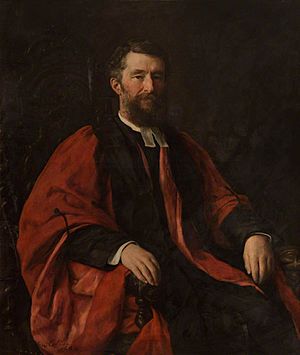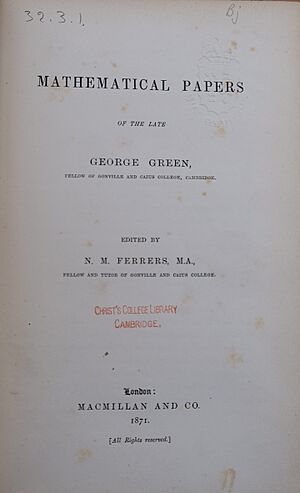Norman Macleod Ferrers facts for kids
Quick facts for kids
Norman Macleod Ferrers
|
|
|---|---|

Norman Macleod Ferrers by John Collier
|
|
| Born | 11 August 1829 Prinknash Park, Upton St Leonards, Gloucestershire, England
|
| Died | 31 January 1903 (aged 73) Cambridge, England
|
| Education | Eton College |
| Alma mater | Gonville and Caius College, Cambridge |
| Known for | Ferrers diagram Nonholonomic constraints |
| Spouse(s) |
Emily Lamb
(m. 1866) |
| Children | 4 sons and 1 daughter |
Norman Macleod Ferrers (born August 11, 1829 – died January 31, 1903) was a British mathematician. He also managed parts of a university and edited a math journal. He is known for the Ferrers diagram and his work on nonholonomic constraints.
Life and Work
Norman Ferrers went to Eton College for his education. Later, he studied at Gonville and Caius College, Cambridge. In 1851, he achieved the top math score, becoming a Senior Wrangler.
He became a Fellow at his college in 1852. In 1880, he was chosen to be the Master of the college. From 1884 to 1885, he served as the Vice-Chancellor of Cambridge University.
Mathematical Contributions
Ferrers made many important contributions to mathematics. From 1855 to 1891, he helped edit The Quarterly Journal of Pure and Applied Mathematics. He also gathered and published the papers of another mathematician, George Green, in 1871.
In 1861, Ferrers wrote a book called "An Elementary Treatise on Trilinear Co-ordinates." He also worked on ideas about how a solid object moves around a fixed point.
In 1871, he suggested new ways to describe motion using "nonholonomic constraints." These are special rules that limit how things can move. In 1877, he published another important book on "Spherical Harmonics."
He also studied how electricity spreads on a spherical bowl. He found ways to calculate the electrical potential in different areas of space.
Ferrers Diagrams
Ferrers is especially known for a way to show how numbers can be broken down into smaller parts. This is called a partition of a number. A Ferrers diagram helps visualize these partitions.
Imagine you have a number, like 7. You can partition it as 4 + 2 + 1. A Ferrers diagram for this would show rows of dots. The first row has 4 dots, the second has 2, and the third has 1.
Ferrers, along with other mathematicians, developed a theorem about these partitions. It states that the number of ways to partition a number n into m parts is the same as partitioning n where one part is always m, and the other parts are m or smaller. This idea can be shown by flipping a Ferrers diagram.
Family Life
On April 3, 1866, Norman Ferrers married Emily Lamb. Her father was John Lamb, a dean at Bristol cathedral. Norman and Emily had five children together. They had four sons and one daughter.
Norman Ferrers passed away at the College Lodge on January 31, 1903.


